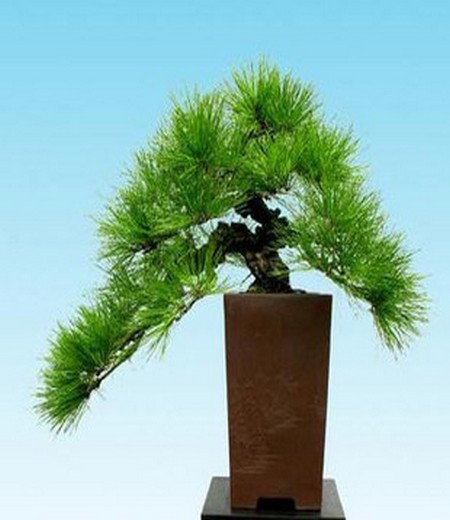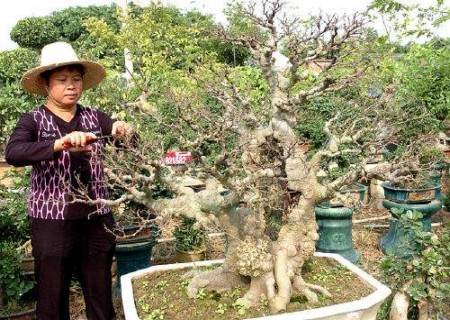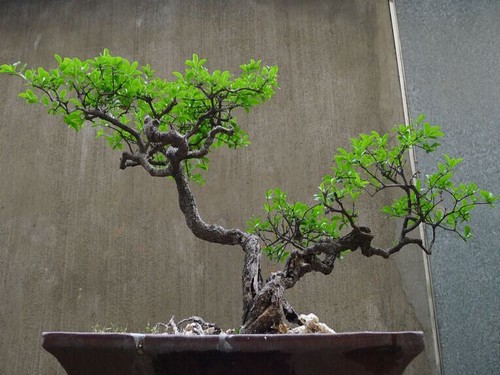How to make Penglai bonsai
Penglai pine stems and branches straight, green color, luxuriant foliage, is deeply loved by everyone's bonsai. However, Penglai pine cultivation management is simple, and good shade resistance, suitable for small and medium-sized pot planting, is a good bonsai production. Then how do you make Penglai pine bonsai? Next, Xiaobian introduces the production method of Penglai pine bonsai for everyone:

Materials: Penglai pine cultivation can be artificial propagation and mountain mining methods:
(1) Artificial propagation: Penglai pine multi-seed seedling propagation, germination rate can be as high as 90% or more. Can be in mid-September to mid-October, late harvest when the cones mature, first stacked for 5~7 days, and then exposed to the sun for 3~4 days, beating and turning, seed out, timely water selection, remove empty particles and sundries, dry bags stored for winter. Penglai pine seed coat thick, slow germination, should be early sowing. Nursery selection of good drainage of slightly acidic soil, soil preparation when applying sufficient base fertilizer. Germination treatment is carried out before sowing. Soak seeds in cold water for 3~7 days (change water during soaking), dress seeds with hydrated lime after soaking, and sow seeds after seed coat cracks. In the middle and late April, the seedlings began to sprout and emerge, and the seedlings of that year could reach 8~12 cm.
(2) Mountain mining: From the mountain forest land, select and find the wild seedlings of Penglai pine with strong and short rod shape, and it is better to use small old stumps growing beside stone gaps, cliffs and ditches. Pay more attention to protecting accessory roots and fibrous roots when mining, and then cultivate embryos in the ground, and then model them in pots after the spring of the following year.
Selection basin: Penglai pine should use purple sand pottery basin, can also be used glazed pottery basin. Just on the pot cultivation, can first use good permeability of the plain burning earthen pot, after serving the pot and then into the shape of elegant purple sand shallow pot. In addition to cliff-style with a deep thousand barrel basin or deeper square and round basin, generally rectangular shallow basin is appropriate. The shape of the basin can also be determined according to the tree shape, such as dry drum can be used shallow round basin, basin color can be purple or light yellow.
Soil: Penglai pine can adapt to a variety of soil, but not saline-alkali tolerance, to deep, wet, loose, slightly acidic sandy loam is good. Pot to mature the pastoral soil, decayed leaf soil, mixed with appropriate amount of sand use.
Planting: Penglai pine potted seeds in March before germination is best, autumn can also be planted, but unfavorable root. When digging saplings, bring soil, cut short the straight roots that stretch too long, and cut off the dead roots. If planted into shallow pots, pay attention to trunk fixation, use iron rod to put the bottom hole along, tie it to thicker root with slightly thicker metal wire, pass out from the pot hole, and then tie it tightly around the iron rod, so as to avoid wind shaking, loose root system and affect survival.
Processing: Penglai pine processing modeling can be mainly tied, pruning as a supplement. Metal wire or brown wire for climbing. The branches of Penglai pine are soft and easy to climb with metal wires. They bend and stretch freely. For example, take 2~3-year-old young seedlings as materials, bend the trunk to a certain extent, cut off the branches that hinder the modeling, and then climb the retained lateral branches into horizontal or slightly drooping shapes. After growing for one year, remove the metal wires, readjust the angle, and then climb and tie them again. After several years, they can be formed. Penglai pine stumps extracted from the mountains can be processed in pots after one year of embryo cultivation. The whole posture modeling must be processed according to the materials, making full use of the natural form of the raw materials, and a little artificial climbing, so that it has a natural wild taste.
Tree shape: Penglai pine bonsai can be made straight dry, inclined dry, curved dry, cliff-style, etc., each with flavor. Straight and dry, vigorous and simple; inclined and dry, elegant and vigorous; curved and dry,"curved and curved back to pan potential, winding and undulating dragon shape"; cliff style, ancient pine valley, danger, Canglong head, want to dive the four seas.
Management: Penglai pine management is relatively simple, spring and summer growth period every half month fertilization, mainly nitrogen, potassium, usually pay attention to pot soil can not accumulate water, otherwise it will cause rotten roots, yellow leaves, autumn should gradually reduce watering. To maintain plant shape, prune frequently.
Spring and summer for its growth season, need sufficient water, but should not make pot soil water, lest root rot; after the end of autumn should gradually reduce the amount of watering, so that pot soil can be kept slightly wet. In order to make the branches and leaves grow luxuriantly, the growing season should pay attention to supplementing nutrients, generally applying liquid fertilizer 1-2 times a month. It likes half shade, hot summer should pay attention to shade, prevent sun exposure, lest branches and leaves burn or yellow.
Time: 2019-05-26 Click:
- Prev

The method of making Pushu bonsai
Park Shumeng has a strong hair force and is easy to take root, and most of the ancient stumps are excavated from the wild. Most of the southern regions choose 23 months of mining, when the temperature rises, the humidity is high, and the excavated trees are not easy to be air-dried and easy to survive. When digging, we should choose stumps with old, good tree shape, dwarf trunk and natural curved trunk.
- Next

A Method for Making Ligustrum lucidum Bonsai
Ligustrum lucidum leaves dense, white flowers purple fruit, evergreen, year-round can be viewed, but the best effect in spring and summer. Take its old stumps, roots ancient dry oblique, Qiu Qu diversity, branches and leaves modeling, overlapping layers, more ornamental value. The following is an introduction to the production method of small privet bonsai
Related
- Fuxing push coffee new agricultural production and marketing class: lack of small-scale processing plants
- Jujube rice field leisure farm deep ploughing Yilan for five years to create a space for organic food and play
- Nongyu Farm-A trial of organic papaya for brave women with advanced technology
- Four points for attention in the prevention and control of diseases and insect pests of edible fungi
- How to add nutrient solution to Edible Fungi
- Is there any good way to control edible fungus mites?
- Open Inoculation Technology of Edible Fungi
- Is there any clever way to use fertilizer for edible fungus in winter?
- What agents are used to kill the pathogens of edible fungi in the mushroom shed?
- Rapid drying of Edible Fungi

